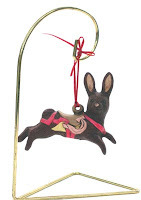Let's define all these types of painting:
Fired colors, also called underglazes, are painted on the raw clay once it is dry, but before it is put into the kiln (it's called 'greenware' at this stage.) Great care must be taken, as greenware is extremely fragile--you can easily crush it in your hand with just a hair too much pressure.
Adding to this stress is the fact that 90% of these underglazes must be worked in 3 successive coats, multiplying the handling time of the greenware immensely. There are some specialized single-coat colors for greenware, but these are normally used only for very small areas, such as for writing something, or for doing eyes or other fine details.
After the item has been fired once in the kiln, it is called "bisque." (Some folks also refer to it as 'whiteware.') At this point it can no longer be so easily broken by hand, unless it is a very fine, thin delicate piece. However, it is now essentially the same stuff as a normal dinner plate--if you drop it, it's going to smash.
Glazes are normally applied only to bisque. There are many types of glazes, both plain colored and specialty types which create many interesting random patterns. (See the blue crystaltone vase in the article just two down for an example.) Once the glaze (again, usually 3 coats) has been applied and allowed to dry thoroughly, it is fired again, at a slightly lower temperature.
The type used depends on the effect you wish. For items which have been pre-painted with underglaze colors, all that remains is to add a clear glaze finish coat. Some glazes have some translucent color and/or speckles in them, which make an interesting finish on the completed item while allowing the base colors to show through fully....see the S&P set at right-----> (click to enlarge)
When working with glazes, you do have to read the labels and pay close attention: not all types can be made lead-free, and those which cannot, such as the crystaltone and other special-effects glazes cannot be used on the insides of any items which will contain food. They should not be used on the outsides of any type of ware which will be in contact with the mouth, such as mugs.
Colored glazes can also be used as the only color(s) on some items, for example, my retro-50's Siamese cats are done only in glaze. I am currently working on a couple of items which will have a combination of colored and clear glazes. This is tricky, as you have to be careful not to overlap the colors as you can to some extent with underglaze colors or stains.
Overglazes are specialty finishes or additions which are applied after the glaze firing, and once the object is cool. Things in this category include gold or silver highlights; decals, and mother-of-pearl, for example. None of these things can be used on an unglazed piece. Once applied and allowed to dry, they require yet another firing to adhere them to the glazed item. This firing is again at a still lower temperature than even the glaze firing. Gold/Silver and mother-of-pearl can be fired in the same firing; decals cannot.
So, the next time you are looking at the price of a ceramic item, note if it has been glazed or not, and whether there are any special extras such as gold or mother-of-pearl. If so, this is all extra labor, time, and cost of firing, which add up. Yes, these items will command a premium price.
Stains, on the other hand, are pretty much a one-step do-it-and-you're-done technique. Most stains cover in one coat...but not always..some colors can be stubborn. Stains do not get used on food containers, only decorative items. These colors are applied only to bisque, and they are water-based. There are hundreds of colors of specialty ceramic stains, but any acrylic paint, such as is found at the local craft store, can be used. For the most part, it is fast and easy to work with stains....that said:
Price point with stains depends more upon the amount of detail in the item and the size. Some of my small hanging ornaments, for example, have such small detail that each one takes over 2 hours of painstaking paint work.
<-------(click to enlarge.)
However, once the painting is done, they can simply be finished off with either a brush-on or spray-on sealer, and that's all. You cannot fire stains: the heat in the kiln will burn the colors right off! (But, if you really foul up, and can't stand the paint job you did...that's a good way to start over.. LOL) ... A stained piece that has been re-fired will not come out completely white again...there will be some residual blotchy color, although very faded.
There are all sorts of other fun techniques that can be done both with stains and with other types of finishes....but that's a whole other article.
Cheers!...Lizzy









No comments:
Post a Comment